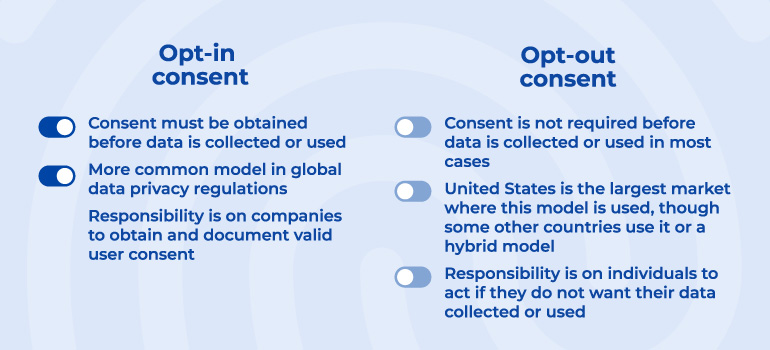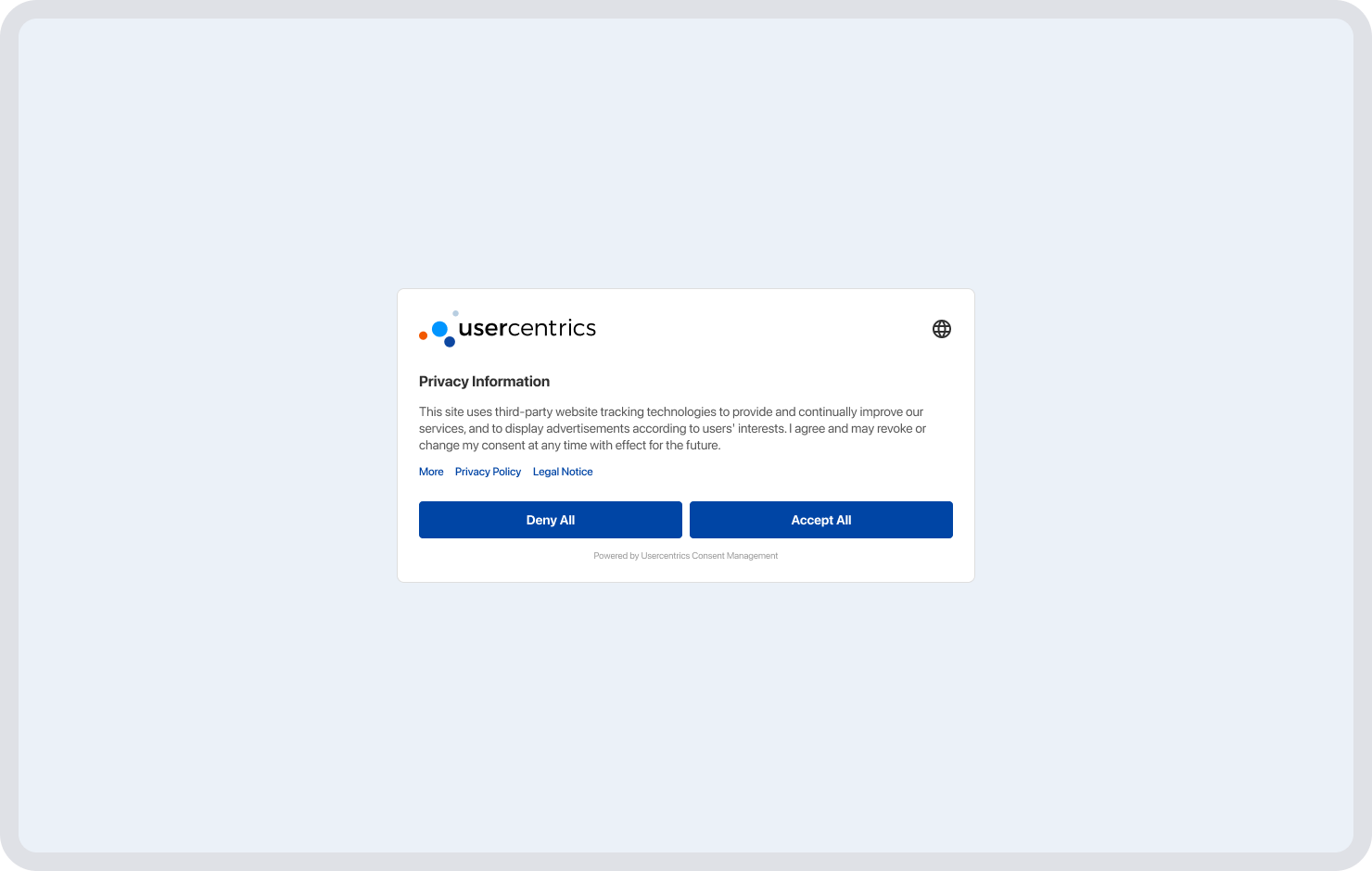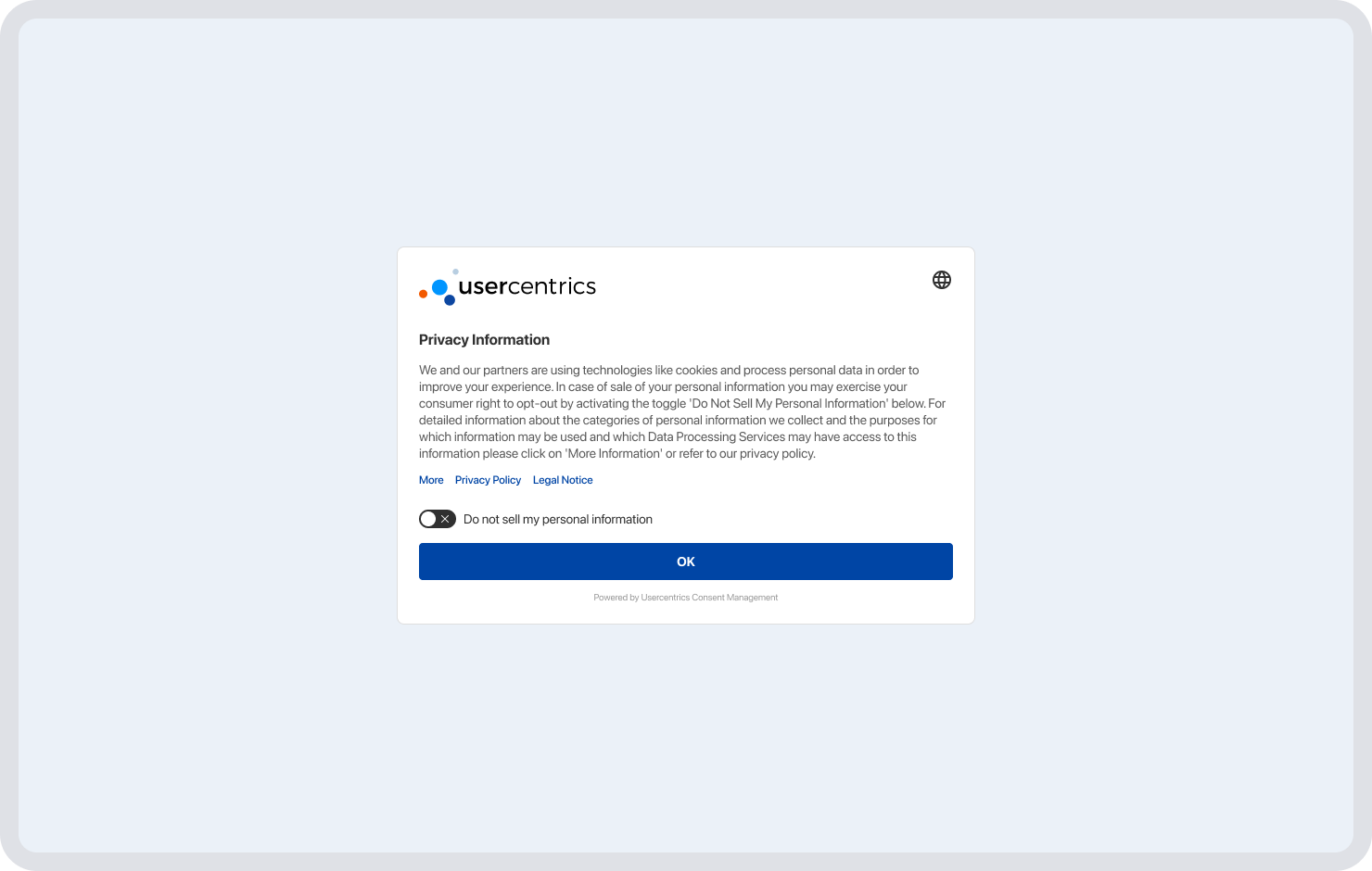When it comes to online privacy compliance, understanding the nuances between opt-in and opt-out consent is crucial for businesses and website owners. These concepts form the backbone of how personal information is collected, used, and shared online.
Different global privacy laws dictate the specific consent model to be used, impacting how website owners engage with their users. Some international companies may have to navigate both models, depending on where their customers are located and relevant regulations.
That’s why it’s vital to understand the differences between opt-in and opt-out consent, the regulatory requirements surrounding them, users’ rights, and best practices for implementing these models effectively.
Opt-out vs opt-in — what’s the difference?
Opt-in and opt-out are both ways of managing people’s consent for collecting, using, and disclosing their personal information online. However, they differ in how they work and the process they take to do so.

To know when a website owner should implement opt-in or opt-out measures, it’s important to understand the difference between the concepts and what each option seeks to accomplish.
What is opt-in?
Opt-in consent requires website visitors to actively and explicitly agree to the collection, use, or sharing of their personal data. Opt-in means website owners must ask for someone’s consent or permission before or at the time when personal data would be collected, like when a visitor arrives on a website.
Example of opt-in consent

Website owners may use this method to seek user consent for storing cookies, subscribing to marketing emails, or for other activities that collect users’ personal data.
For example, when creating an account on Amazon, users will need to fill in a form, provide their name, email address, and create a password. Below this is a section dedicated to communication preferences, and there’s an unchecked box with the following text:
“Yes, I want to receive personalized product recommendations and exclusive deals from Amazon. By checking this box, I agree to receive marketing emails. I understand I can unsubscribe at any time by clicking the link in the email or adjusting my account settings.”
To agree to this, users need to take action and check the box. It is not pre-checked.
By presenting this opt-in choice, Amazon ensures that customers who receive marketing communications have actively consented to do so, aligning with data protection regulations and respecting user preferences.
A common sight for consumers online in the European Union — and increasingly around the world — is consent banners that pop up when people arrive on websites for the first time (or after a long period when previous consent choices may have expired). These banners request consent for the use of cookies that collect personal data, which can include contact, financial, and order information for ecommerce transactions, or tracking of user behavior to improve website performance or marketing initiatives. This is also the opt-in model of consent in action.
Which global privacy laws require opt-in consent?
Several global privacy laws and frameworks mandate that website owners use an opt-in consent model. These include:
- General Data Protection Regulation (GDPR)
- ePrivacy Directive (also known as the “Cookie Law”)
- Brazil’s Lei Geral de Proteção de Dados (LGPD)
- South Africa’s Protection of Personal Information Act (POPIA)
- China’s Personal Information Protection Law (PIPL)
It’s important to note that while these laws generally require opt-in consent, the specific requirements and circumstances under which opt-in consent is necessary may vary. Some laws may have exceptions or different standards for certain types of data processing. Additionally, the implementation and enforcement of these laws can differ across jurisdictions.
The list above covers the more well-known privacy regulations, but it is not exhaustive. Website owners are encouraged to conduct their own research depending on their region of operation. Generally, the opt-in consent model is the most common globally.
What is opt-out?
The opt-out consent model requires website owners to share that they collect personal data, how it is used, and other information, but they do not have to get explicit user consent before collecting or processing the data.
Individuals have the option to take specific action to refuse or withdraw consent at any time, however, for functions like the sale or sharing of their data, or its use for profiling or targeted advertising, depending on jurisdiction. Individuals are responsible for actively opting out if they wish to protect their data.
A common exception to this is when the personal data in question has been categorized as “sensitive”. This is data that can be extra harmful if misused and can include information like healthcare history, sexual orientation, financial information, religious beliefs, and more. The data of known children is also commonly categorized as sensitive by default. For sensitive data, prior consent (opt-in) is typically needed, from the parent or guardian in the case of children.
Example of opt-out consent
The California Privacy Rights Act (CPRA), which amends and expands the California Consumer Privacy Act (CCPA), provides a clear example of an opt-out consent model.

Imagine a popular ecommerce website that operates in California. Under the CPRA, this website can collect and use customer data for various purposes, including targeted advertising and sharing with third-party partners, without obtaining explicit consent upfront. However, the law requires the website to provide consumers with a straightforward way to opt out of these practices.
To comply, the ecommerce site must prominently display a “Do Not Sell or Share My Personal Information” link on its homepage and in its privacy policy. When a customer clicks this link, they are directed to a page where they can exercise their right to opt out of the sale or sharing of their personal information. The website must then honor this request and stop selling or sharing that customer’s data.
Also under the CPRA, companies that process sensitive personal data are required to implement a link reading “Limit the Use of My Sensitive Personal Information” to enable visitors to exercise their rights, or a “single, clearly-labeled link if such link effortlessly allows a consumer to opt-out of the sale or sharing of the consumer’s personal information and to limit the use or disclosure of the consumer’s sensitive personal information.”
Read about eCommerce consent requirements now
Which privacy laws allow opt-out consent?
Multiple global privacy laws authorize website owners to use opt-out consent models. These include:
- California Privacy Rights Act (CPRA)
- Colorado Privacy Act (CPA)
- Virginia Consumer Data Protection Act
- Connecticut Data Privacy Act
- Utah Consumer Privacy Act
- Japan’s Act on the Protection of Personal Information (APPI)
- South Korea’s Personal Information Protection Act (PIPA)
- Singapore’s Personal Data Protection Act (PDPA)
- Canada’s Personal Information Protection and Electronic Documents Act (PIPEDA)
It’s important to note that while these laws generally permit opt-out consent, the specific requirements and circumstances under which opt-out consent is allowed may vary. Some laws may have exceptions or different standards for certain types of data processing.
Additionally, the list above covers the more well-known privacy regulations, but it is not exhaustive. Website owners are encouraged to conduct their own research depending on their region of operation.
Best practices to collect opt-in consent
Read about cookie opt in now
If you collect personal data from people in the EU, sensitive personal information, personal information from minors, or use non-essential cookies (including third-party cookies), you most likely need explicit consent and must implement an opt-in consent model, unless another lawful basis for processing applies.
To ask for opt-in consent in a privacy-compliant manner, there are eight steps website owners must follow. These are:
- Be clear and transparent: Use plain, easy-to-understand language to explain what data you’re collecting, how it will be used, and other parties that may have access to it. Avoid legal jargon or complex terms. This is often done via a cookie banner.
- Make it specific: Obtain separate consent for different purposes rather than using blanket consent. This enables users to choose which activities they want to opt in to.
- Use active opt-in methods: Use unchecked boxes, toggles set to “off” by default, or explicit confirmation buttons. Avoid pre-ticked boxes or other methods that assume consent, as manipulative design to encourage consent is strongly frowned upon by authorities.
- Provide granular options: Enable users to select which types of data they’re willing to share or which specific activities they consent to.
- Make it easy to withdraw consent: Provide a clear and simple way for users to change consent preferences or withdraw their consent at any time.
- Use just-in-time consent: Request consent at the moment you need to collect or use the data, providing context for why it’s needed. A blanket “clickwrap” agreement is not compliant with most personal data collection regulations.
- Keep records: Maintain detailed records of when and how consent was obtained for each user, and any changes over time.
- Test different approaches: A/B test different UI configurations and/or consent flows to find what works best for your users while maintaining privacy compliance.
By following these eight steps, website owners can gather opt-in consent in a manner that complies with the GDPR, LGPD, and multiple other global privacy laws. This process also respects user privacy and builds trust.
Best practices to collect opt-out consent
If you are collecting and processing personal data in a jurisdiction that allows you to do so without obtaining prior consent, you will still legally need to notify users and enable them to opt-out.
To do this in a CPRA-compliant manner, for example, here are eight best practices website owners must follow. These are:
- Clear and prominent notice: Provide a clear, conspicuous notice about data collection and use practices, along with an easy-to-find opt-out option. This could be a prominent link or button labeled “Do Not Sell or Share My Personal Information” or similar, depending on what the relevant regulation outlines.
- Easy opt-out process: Make the opt-out process simple and straightforward. Avoid multi-step processes or requiring users to create accounts to opt-out.
- Clear communication: Explain in simple terms what opting out means for the user’s experience and what data will no longer be collected or shared.
- Timely response: Process opt-out requests promptly, typically within 15 days, as required by laws like the CPRA.
- Granular options: Enable users to opt out of specific data uses rather than only offering an all-or-nothing approach. This also benefits marketing operations, as some data collection can be maintained with the user’s consent.
- Maintain records: Keep detailed records of opt-out requests and how they were honored.
- Respect opt-out duration: Once a user opts out, honor that choice for at least 12 months before asking them to opt back in.
- Third-party compliance: Ensure that any third parties you share data with also honor user opt-out choices. Under many laws, the controller has ultimate responsibility for privacy compliance, including the activities of third-party processors working for them.
By implementing these practices, website owners can create a transparent and user-friendly opt-out process that respects privacy rights while complying with relevant data protection regulations.
Email marketing and opt-in or opt-out
Email marketing requires businesses to navigate the rules around opt-in and opt-out practices.
Opt-in emails are essential for ensuring that consumers have willingly provided their email addresses for marketing purposes.
Most countries, including New Zealand, Canada, Australia, Hong Kong, Singapore, the United Kingdom, and all European Union countries, mandate explicit opt-in consent.
To comply, businesses should display an unchecked checkbox for users to select if they want to receive marketing communications and include an easy opt-out option in every subsequent email.
In contrast, opt-out practices focus on allowing recipients to unsubscribe from marketing emails they no longer wish to receive.
This approach is particularly relevant in the United States, where the CAN-SPAM Act governs direct marketing practices.
The Act requires that all marketing messages be clearly identifiable as commercial communications, provide a simple and prominent unsubscribe mechanism, and include accurate header information and subject lines.
Additionally, organizations must provide a valid physical postal address to inform recipients of their location.
Combining these practices ensures that businesses respect consumer preferences while complying with international and local regulations, thereby maintaining trust and improving the effectiveness of their email marketing campaigns.
What is double opt-in, and when is it necessary?
Double opt-in is an email marketing consent process that requires subscribers to confirm their subscription through a verification email after initially signing up. This process typically involves a user submitting their email address through a signup form, receiving a confirmation email with a verification link, and clicking the link to confirm their subscription and be added to the mailing list. This mechanism is used for marketing emails, newsletter subscriptions, and other voluntary communications.
Double opt-in is necessary or beneficial in several scenarios:
- While not explicitly required by GDPR, double opt-in provides stronger proof of consent, which can be helpful for proof of compliance with data protection authorities.
- It helps ensure list quality by filtering out passive prospects, bad emails, and spam accounts, resulting in a higher-quality mailing list with better engagement rates.
- Double opt-in improves email deliverability by verifying email addresses, which can reduce hard bounces and enhance overall email performance.
- The confirmation email can be used as an opportunity to welcome new subscribers and introduce your brand, creating a more personalized experience from the start.
- Double opt-in prevents problems related to typos in signup forms or users submitting email addresses that don’t belong to them.
- Although it may result in a smaller list initially, double opt-in helps to ensure that your subscribers are genuinely interested in your content, potentially leading to higher engagement rates.
Double opt-in has benefits, but it’s also worth noting that it could result in slower list growth compared to single opt-in. However, the trade-off is often a more engaged and higher quality subscriber base, and more robust and trustworthy consent management practices.
Preference management
One potentially important addition to the marketing toolkit for companies is preference management, which works hand in hand with consent management. It’s also a source of zero-party data, which is something of a “holy grail” in marketing as it’s high-quality data that comes directly from customers. This is even more valuable with the phasing out of third-party cookies.
Preference management involves obtaining information from customers about their interests and preferences directly, like whether they prefer marketing emails or SMS notifications, or if they want communications about sales only or also about new product launches, etc.
This information can be collected in a dedicated preference management center, or account settings, via surveys, and other mechanisms. The advantage of consent management is that companies then have explicit information about what customers want, and their consent to deliver it in specified ways.
Choose the right approach for your data privacy needs
Navigating the complexities of opt-in and opt-out consent models is essential for maintaining compliance with global privacy laws and respecting user preferences.
Opt-in consent requires explicit agreement from users before their data can be collected or used, ensuring a high level of transparency and user control. Conversely, the opt-out model presumes consent until the user explicitly withdraws it, placing the onus on users to protect their data and privacy in most cases.
Understanding and implementing these consent practices, along with adhering to specific regulations like the GDPR, helps businesses build trust, enhance user engagement, expand Privacy-Led Marketing operations, and stay compliant with data privacy requirements.
Read about marketing compliance checklist now.
By following best practices for both consent models, website owners can create a user-friendly and legally sound environment for their online activities, no matter where their visitors are located.


